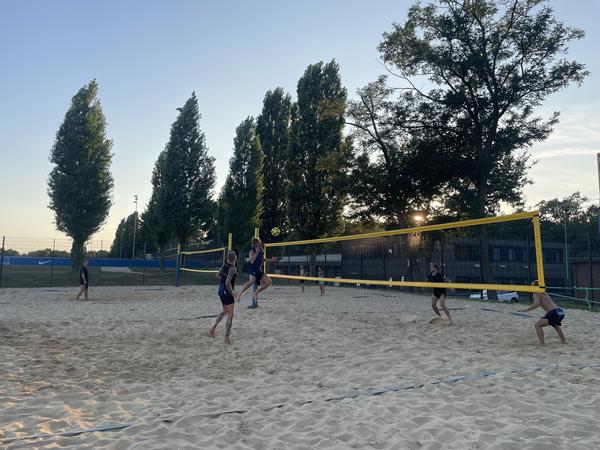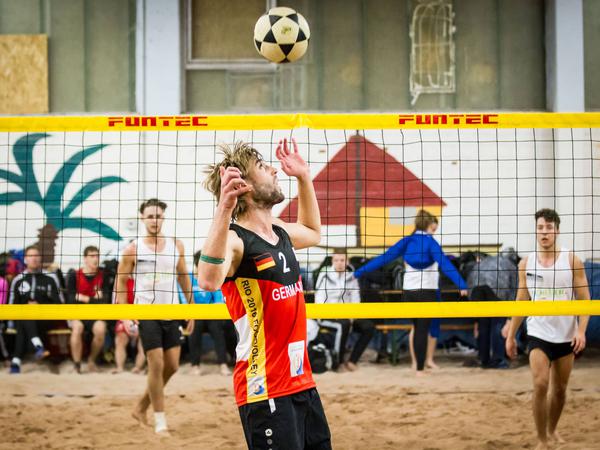Soft evening light falls through the trees and turns the sand golden. Two balls fly through the air, people jump up from the net. There is a sense of exuberance like on the Copacabana in Brazil. When a shark attack occurs, the illusion is almost perfect.
This sand is actually located in the Olympic Park in Berlin. The nearest water is only 100 meters away, but a shark is certainly not going to attack from the swimming pool. The supposed attack is actually a quick foot over the edge of the net that kicks a ball to the opponent’s side. This is what the attack is called in footvolley.
On two beach volleyball courts Here, two players play against two. The game itself is very similar to beach volleyball, except that all body parts can be used except the arms.
Recommended editorial content
Here you will find external content selected by our editors that enriches the article with additional information. You can display or hide the external content with one click.
I agree to the external content being displayed to me. This means that personal data can be transmitted to third-party platforms. You can find more information about this in the data protection settings. You can find these at the very bottom of our page in the footer, so that you can manage or revoke your settings at any time.
: (10.09.24)
In concrete terms, it looks like this: for the serve, the players build a small hill on the baseline and kick the ball over. The ball is usually received with the chest, then passed to the partner, who then hits the ball back sharply over the net with either his head or foot – or with an overhead kick, known here as a shark attack. A set goes up to 18 points; whoever wins two sets first wins the game.
“It’s the best sport, even for older people,” says Joel Nisslein. The 37-year-old started playing the sport in 2012, taught himself almost everything, is now one of the best players in Germany and also plays at the top of international tournaments. At the end of August, Nisslein and his partner Lukas Kicherer became vice-European champions in Corsica.

© Tanja Kunesch / TSP
It all started in 2009 with a course at the Free University of Berlin. Nisslein played beach soccer there and was soon playing on the sand for Hertha BSC and the national team. When he and a few other players were in the hall in Wittenau one winter, nets were still set up on the sand courts. A few had heard of footvolley, which is particularly popular in Brazil, and tried it out.
Recommended editorial content
Here you will find external content selected by our editors that enriches the article with additional information. You can display or hide the external content with one click.
I agree to the external content being displayed to me. This means that personal data can be transmitted to third-party platforms. You can find more information about this in the data protection settings. You can find these at the very bottom of our page in the footer, so that you can manage or revoke your settings at any time.
The sport originated in a similar way in the South American country: In Rio de Janeiro, football was banned on the beach in the 1960s, but beach volleyball nets were still everywhere. So the players started kicking the ball with their feet on the court.

© imago/Eibner
It is now bigger than volleyball. Former and still active football professionals play themselves, like Neymar, Romario or RonaldinhoThis has helped the sport achieve great success. “For us, the level in Brazil is like the NBA in basketball,” says Nisslein. Whether Toni Kroos will retire after his professional career also moves to the sand? “We would have to ask him,” says Nisslein.
The sport has one big advantage over football: significantly fewer injuries, which mainly occur through direct contact, and it is gentler on the joints.
“I like doing things with my feet, and here there are so many more touches on the ball than on a football field. You can also develop all parts of your body,” says Nisslein. In 2012 there was no training or idea of the sport in Germany, just a few YouTube videos.
But that didn’t stop the child and youth therapist: Over the years, he has taught himself a lot, has been to Brazil five times and came fourth at the 2016 World Cup with his partner Mo Obeid. “What we did was a bit of pioneering work,” says the national player.
Hertha has had a footvolley department since 2018, which Nisslein founded. He gives courses there and in cooperation with Beachzeit, a training program originally for beach volleyball. “It’s a demanding sport that doesn’t forgive many mistakes,” says Nisslein. “Footballers have a clear advantage, but beach volleyball players benefit from their understanding of the game on the court and their approach behavior. It’s best to have access to both.”
Indrah Shah proves that this is not a must. The 46-year-old actually comes from tennis, but has been playing footvolley for eight years. “I love the sport, in the sand in the sun. You don’t need any equipment, your whole body is involved. You never get bored,” she says. The best thing is that the sport is acrobatic on the one hand, but also very playful. “Everyone brings their own style.”
However, women are still in the minority. At Hertha BSC, there are currently four active women, but 20 men. “I think the inhibition threshold is perhaps even higher, and visibility is not as great,” says Shah. The reception with the chest is more difficult, but many women simply do it with the shoulder. “That works just as well, but we just have to be more precise.” Shah also admits that you have to have a high tolerance for frustration. “But it’s worth sticking with it!”
Perseverance has also paid off for the sport itself: it has now established itself in more than 20 locations in Germany, and the German rankings include around 300 active players. The European Footvolley Federation has existed since 2003, and the German association since 2007.
Whether the sport will ever become an Olympic sport? “For many, this is a dream that would of course come with more support,” says Nisslein. “The sport still has its charm and a bit of the magic of the new. There is no one who regulates everything drastically.”
But the national player also criticizes social issues: “Competition is of course cool, medals are cool, but that doesn’t add value to society. My goal is to get more people playing football, to motivate them to exercise. And for them to have fun doing it.”
